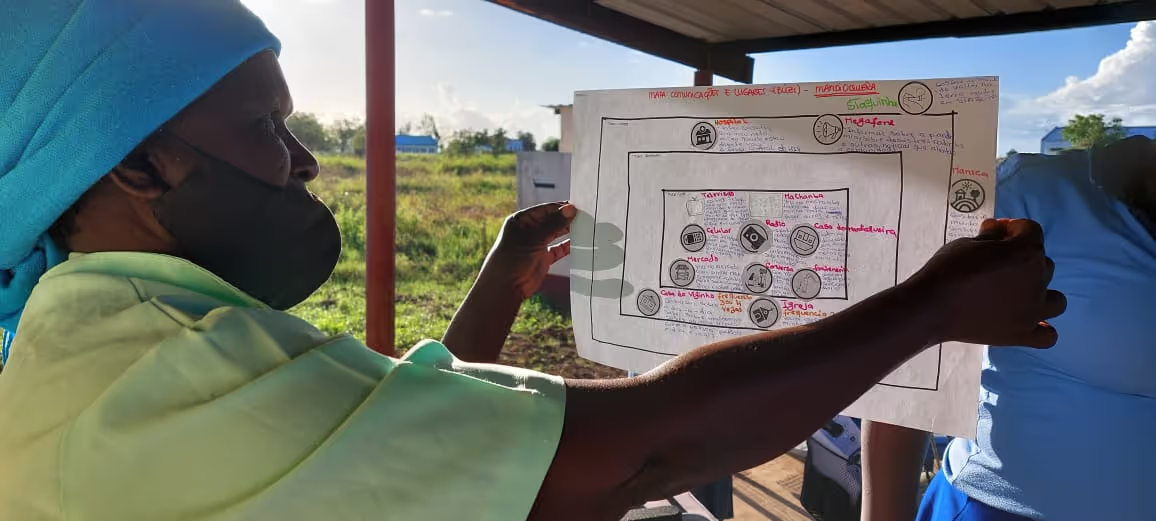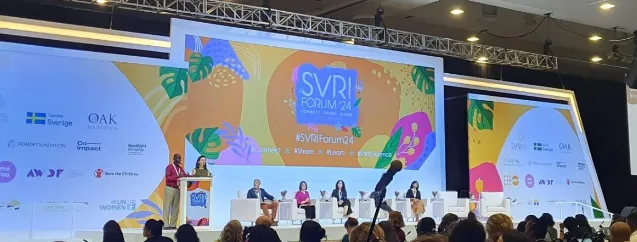Inclusivity through creativity: a research approach that leaves no one behind

On March 14th 2019, the tropical Cyclone IDAI hit an area close to Beira city. Strong winds and intense rain in the following days left a trail of destruction with an estimated 3.000 km2 of land flooded, 715.000 hectares of farmland underwater, and damage to infrastructure, such as radio and network communication, houses, school buildings and hospitals. Thousands of people were killed or injured and millions displaced. Some of those displaced are now in resettlement sites. The frequent flooding that affects the region, in addition to the COVID pandemic, makes it a protracted emergency.
Recent analysis shows that over 1.6 million people face severe acute food insecurity. People with disabilities and elderly people are amongst those hardest hit by this humanitarian crisis, yet their needs are often not taken into account when designing humanitarian responses. By making the response effective for them, we make the response inclusive for everyone. The only way to do that is tapping into creative user-centred methods.
In July 2021, around forty people with visual, auditory and physical disabilities, and elderly people were part of the Exploration Lab as active researchers of their lived experiences in a disaster-prone region. During the two weeks, they participated in activities to share their perspective; for instance, in dealing with COVID-19 and Cyclone Idai. This is part of the “We are part of the solution” project. A user-centred exploration of preparedness needs and opportunities with people with disabilities and older people in Mozambique for inclusive humanitarian emergency preparedness and response. A participatory, generative, inclusive and creative journey for the participants and for the research team.
A participatory research approach means that participants become the researchers of their own lives.
The research activities took place in Beira and Buzi, cities that were severely affected by the cyclones and floods in the last years. People with disabilities and the elderly were invited to share their experiences, their daily routine, their fears and dreams, through different design research activities.
"All that was done in the session, I was also able to do! And when the facilitator spoke, she also asked me to talk. I felt included!"
All research tools used in the process were adapted to the context and cultural aspects with the aim of drawing out experiences using a combination of visual and verbal storytelling. The activities spark conversations to uncover insights around the themes of communication, autonomy and inclusion. During each session they focused on a different topic. For instance, in the Future Me activity, participants were invited to create a personal profile of their strengths, motivations and future expectations. In the Communication Mapping activity, they visualised the communication channels they use the most, and the ones they don’t use at all. In the Location Map, the locations they have access to, and the ones they would like to have access to.

Another key research method was user journeys. Participants create a chronological storyboard of their experience in an emergency. For COVID-19 they shared how they found out about it, where they got more information, which measures they took themselves, which measures they needed support with, and which aspects they wished were different. For Idai they shared how they received information (or not), how they prepared, which type of support they had access to, and how they could feel more included. Using drawings, sculptures and roleplay, the method allowed them to revisit difficult moments in a lighter way, highlighting aspects and ideas for more inclusive information provision, community engagement, and decision making.
Generative methods invite people to gain new knowledge and insights about themselves through research activities.
Generative methods focus on self-reflection and learning opportunities for participants. The immersive nature of the sessions and activities allows participants to go beyond their own assumptions about a certain topic and understand the reasons behind their actions.
Besides the facilitated group sessions, the participants were invited to complete individual activities in their own time. One included registering moments in their day where they felt good, bad, included and excluded. By repeating the same activity every day for a week with tools like the Diary and Photo Collection, they have the opportunity to explore their routine and environment. This helps them learn more about their feelings, their social connections and their aspirations. This uncovered knowledge about themselves plays an important role in deepening discussions during the group sessions.

Besides the personal knowledge level, the research process represents an opportunity for participants to understand how others experience daily challenges and events such as the restrictions and fear imposed by COVID or dealing with trauma caused by the effects of the cyclone and the floods. It is empowering to discover that you are not alone, and you can learn ways to cope with difficulties with others.
“I liked the sessions because we told certain stories of what happened in the past.”
“I have learned that when we are together as a majority, we are respected!”

Inclusivity and creativity go hand in hand. You are creating a safe space to address personal and difficult topics.
It is extremely important to build trust among participants and create a safe space to share, discuss, co-create, disagree or change opinions about something. Inclusivity and creativity go hand in hand to create such openness to vulnerability and exchange, keeping a light and positive perspective.
In the Exploration Lab in Beira and Buzi, each session started in the exact same way: participants received a piece of modeling clay to express how they felt. By the end of each session, they would go back to their sculptures and compare what had changed. This simple activity, that in the first session caused some discomfort, ended up being the highlight of the process for many participants.

“I made a spoon, as I am being nourished with new knowledge.”
“I feel like I am playing. The modeling clay makes me go back to my childhood, I feel good! “
I feel like I am being nourished here in these sessions. These are all new things for me, these drawings and sculptures I am making.
“It is like I am back in school!”
At first it can be challenging to draw and make sculptures, putting oneself in a playful position. “I don’t know how to draw” or “I am a grown up, I am not supposed to play!” -- we heard from some of the participants on the first day. As a researcher you sometimes need to help participants go beyond their initial hesitation and try something new. This is especially important when aiming to create an inclusive space for people with different types of disabilities, levels of literacy and dexterity. Offering different creative alternatives to express oneself is a great way to be inclusive. Especially when those means of expression are new to all participants, they create a level ground to learn and experiment together. To complete the activities, the participants could write, draw, role play, or make a sculpture.
Using modeling clay was especially effective to create moments of reflection before sharing their answer. It helps alleviate the anxiety of giving a ‘right’ answer. The most important rule of the Exploration Lab: there is no right or wrong, we are all experts in our own perspective of the world.

The openness and creativity also applies for the research team and facilitators. The activities and resources were planned, tested and adjusted to make sure they work taking into account the research participants and their culture context. For this research we also had people with disabilities as co-facilitators of the sessions and as co-designers of the tools to adjust them to the context. These adjustments happened not only in the planning phase, but also during the actual sessions.
It is very important to take the time to listen to people, and that does not always come in the shape of words, but also by observing how they react, what is working and what needs to change. Above all, make space to adapt the plan and still reach the objectives of the research in a way that makes the people feel comfortable, heard and taken care of.
“When I am home I feel isolated, here I am feeling well. Since Monday I haven't taken my pills for blood pressure. And nothing happened. Here, my blood pressure is actually going down. I am happy! If I could, I would like to keep coming for 5 more days… (followed by a big laughter)”
“I forgot about the challenges from home… We were cherished. I feel like a newborn baby.”
Giving people the opportunity to have a say and work towards the future they want
We call the approach used an Exploration Lab: a participatory, creative, generative and inclusive research approach that results in insights that are fully based on people’s perspective and needs. It places participants' opinions at the centre of the process. It is a method that allows us to navigate complex themes and find new angles to build innovative solutions.
The design research activities are shaped to move us beyond our assumptions, first answers and initial ideas. It relies on participatory research, where the participants act as researchers themselves and actively participate in the research rather than attending from a passive role. The participants can share things from their own perspective and have the ability to uncover things that are important to them. This approach creates inclusive opportunities to reflect and learn, empowering people to not only imagine a desired future together, but also see themselves as the main actors in the change they want to see.
The Exploration Lab method ensures a deep level of understanding of participants needs and wishes, in relatively little time.
The following points are recommendations for anyone who is conducting research to understand human behaviour. They will help to generate more authentic and insightful perspectives on the situation:
- Develop tools as conversation starters to break the ice and invite deeper conversations
- Create opportunities for people to reflect on their own experiences, and learn more about themselves
- Use creativity as a bridge to difficult conversations
- Offer alternative ways for people to express themselves
- Take time to listen, observe and adapt the plan, invite participants to do the same this will build a safe space for people to share their personal experiences and opinions
“We are part of the solution: a user-centred exploration of preparedness needs with people with disabilities and older people in Mozambique for inclusive humanitarian response” is a project collaboration between @LightfortheWorld, @ButterflyWorks, @InkDot @FAMOD, @ASSADEC and @HelpAgeInternational. Next steps will include the co-creation of community-based and systemic solutions for a truly human centered humanitarian preparedness and response.
Stay updated
Sign up for our newsletter to receive regular updates on resources, news, and insights like this. Don’t miss out on important information that can help you stay informed and engaged.
Related articles



Explore Elrha
Learn more about our mission, the organisations we support, and the resources we provide to drive research and innovation in humanitarian response.